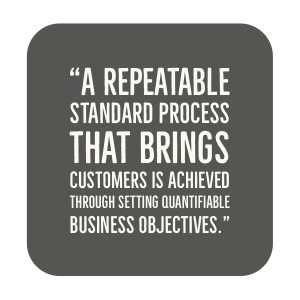Almost every company would love a repeatable standard process that brings customers and value. This is usually the aim of the marketing team but how do you achieve this? Through setting measurable objectives, communicating them and monitoring performance. That’s how!
When it comes to setting objectives the marketing Department is not exempt. Yes, I know objectives and measures are common in transactional settings but here’s the rub. If you’re not measuring it you’re not managing it and when it comes to the “it”, well that’s your marketing objectives.

With the right objectives in place, this does not have to be merely aspirational. The challenge is, of course, to devise a correct set of objectives make this a reality. Many companies find this immensely difficult but it needn’t be. Think of it as setting a map to a destination with each objective a little step on the way.
While marketing team objectives can of course vary from company to company, they are usually based on a theme i.e.
1 Increased levels of sales
2 Increased levels of new customers
3 Improved relationships
4 Increased market share
5 Entrance to new markets or products
Commonly you might find these (or others) as top-level objectives with a subset of objectives underneath. For example, where you’re looking to improve relationships, you might have a series of objectives underneath, for example expanding your reach on social media, or recorded customer satisfaction levels captured via your service team.
And, finally of course setting the objectives is only part of the task we will also need to be thinking of an appropriate set of measures to drive these objectives as well.
Again each of these helps build towards a larger set of objectives that satisfy the need of the company.
Of course there are many other goals and objectives that could be associated with the marketing team and these are just examples but they give you a flavour of where marketing should be looking at when setting the business goals. When many businesses fail though is that they make these objectives merely aspirational without looking at applying time-based or quantitative targets that can be measured. Without these objectives are just pipe dreams.
For example, the business may look at an objective of improving brand awareness. In this case, the leadership should look at how we can achieve this quantitively, How could it measure it?
All too often, however, companies struggle with the data. However, this shouldn’t be limiting. There is usually a raft of 3rd party tools that can assist with data capture and analytics. For example look at the world of social media. Without delving into the there are examples of tracking tools that can track mentions of a particular brand perhaps using third-party content management systems or looking at social media reach for example.
As with most departments, re-sources for the marketing team are not exhaustive and it’s important to choose the right strategy that drives the business in the direction it is looking to move. Once you have the right objectives, of course, the next step is to build the action plan which will deliver these.
So these are our thougths on defining and implementing marketing departmental objectives. Have some thought of your own? We’d love to hear from you in our comments section below.